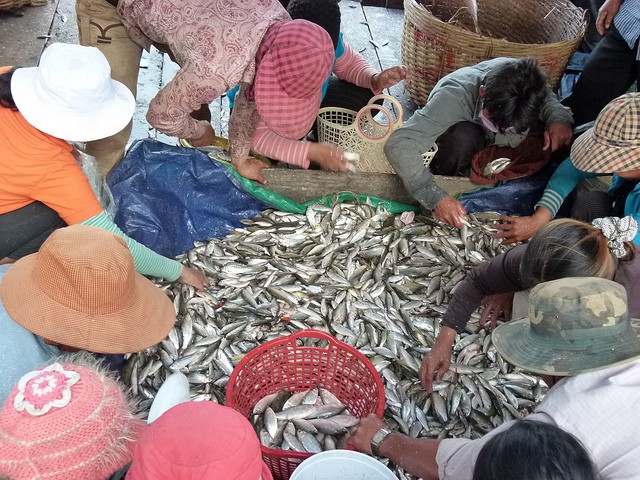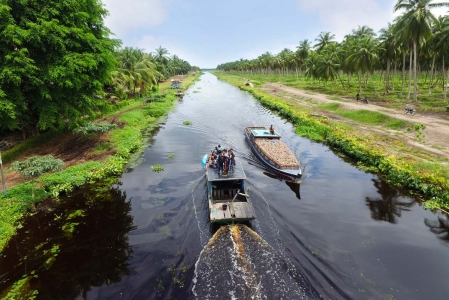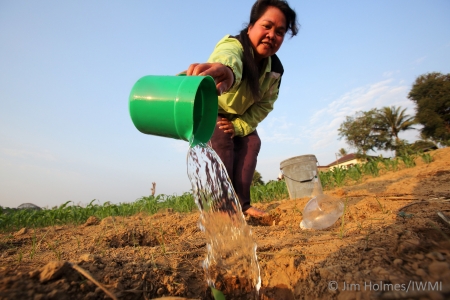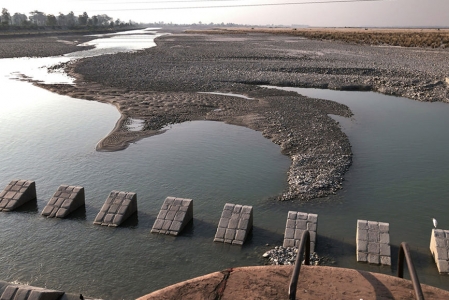In the Mekong River Basin, hydropower has great potential to bring economic prosperity and electrification to rural communities while meeting the growing power demands of urban centers. But ensuring the benefits from hydropower are equitably shared within nations as well as at the river basin scale is not easy. Even more challenging is implementing measures that prevent any one part of society from carrying the brunt of the costs, be they monetary, social, or environmental.
 Fisherman downstream in the Mekong River Basin harvest fish. At the Cambodian government dai research station. Photo: CPWF on Flickr
Fisherman downstream in the Mekong River Basin harvest fish. At the Cambodian government dai research station. Photo: CPWF on FlickrIn order to discuss these important issues, a meeting was held on March 20-21 in Vientiane, Lao PDR. Organized by the International Water Management Institute (IWMI), the workshop focused on examples of benefit sharing mechanisms and payment for ecosystem services (PES) for hydropower in various national settings.
What generally happens with PES schemes is that hydropower companies or downstream populations (who benefit from the electrification, irrigation, or river flow regulation brought by dams) pay upstream communities and those who live in the watershed to protect the ecosystems that provide services which support the dam’s functions.
This could be anything from protecting forests to reduce the amount of sediment that gets deposited into the dam reservoirs, to preserving vegetation that increases the amount of water that flows into hydropower dams. In Southeast Asia, some of the services included in PES programs are reduction of erosion and maintenance of water sources, carbon sequestration and retention, biodiversity, and protection of aquaculture that are subsequently provided.
Vietnam turns to PES
In Vietnam, a great deal of legislation has been passed to support Payment of Forest Ecosystem Services (PFES). Started as a pilot project in Lam Dong and Son La provinces in 2008, the program initially worked with the Da Nhim and Hoa Binh Hydropower plants, as well as tourism and water companies, to set up payments to local forest protection boards and the households that they contracted. The program was then expanded to the national level in 2010.
According to Dang Thuy Nga from Winrock International, who has been instrumental in making PES a viable option in Vietnam, it hasn’t been an easy process. Having the right legislation to be able to implement PFES took some years, after which planning and educating stakeholders on the process was rather complex. In addition, forest conservation schemes are very convoluted and take a great deal of monitoring, resources, and time.
Some latent issues exist:
Hydropower companies are sometimes slow to pay for forest ecosystem services because they perceive a lack of transparency and clarity on how payments will result in the maintenance or creation of services. In fact, convincing the companies that the services are ‘required’ and can lead to long-term benefits is also sometimes a challenge.
Land rights and ownership are also sometimes ambiguous and can result in difficulty identifying who owns certain forestland. Finally, specifying the types of forests and the services they provide can be quite convoluted; in some cases, people have been paid through the program for their rubber ‘forests’, even though plantations can actually contribute to erosion problems instead of alleviating them.
Improving future PES schemes
Nga has not given up on ways to improve the program. Revising existing legislation, collaborating with more agencies, organizations and communities, and continuing to streamline the payment system are all suggestions she made to ensure the program functions better in the future.
These suggestions were all very much in line with the criteria that workshop participants felt needed to be in place to make PES, and in fact benefit sharing mechanisms in general, successful.
Accompanying legislation and government support is essential to provide programs with a legal basis. Involving all relevant parties in the development and decision making process of a program increases their investment in it and can potentially lead to longer-term sustainability. Building flexibility into programs makes it possible to continually improve and streamline processes, thereby ensuring that the mechanisms developed meet the needs being addressed.
So how can we take the lessons learned from Vietnam and apply them to a larger trans-boundary context? Are national schemes even comparable to international collaborative efforts?
This topic will doubtlessly be discussed at the Mekong River Commission meeting on benefit sharing and hydropower this week in Ho Chi Minh City, Vietnam (April 10-11), but please share your thoughts with us.
What are some good examples of national or international benefit sharing programs? How can these examples help ensure that benefits are shared equitably and for the good of people, economies, and ecosystems?













